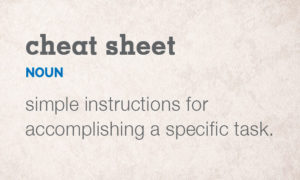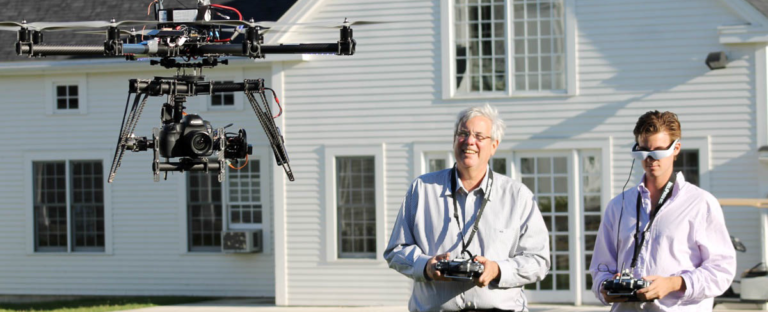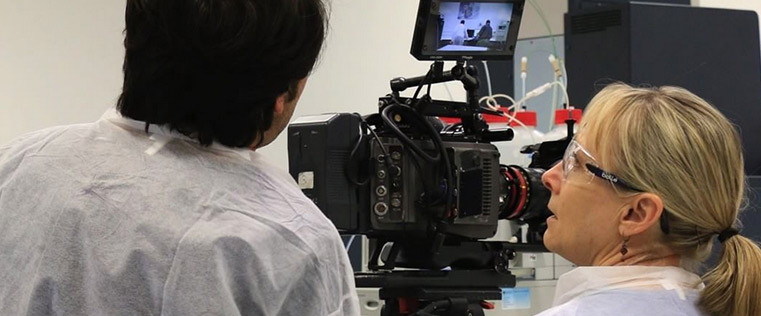For Marketers: The Ultimate Video Production Cheat-Sheet
by Catie Foertsch
 Here in Boston, video production runs the gamut from quick one-camera shoots to high-end projects with multiple cameras, multiple shoot days, and very complex edits. But regardless of how big or small a video project is, we find that our projects go more smoothly, and our clients are happier with the outcome, when there’s a basic understanding of the video production process.
Here in Boston, video production runs the gamut from quick one-camera shoots to high-end projects with multiple cameras, multiple shoot days, and very complex edits. But regardless of how big or small a video project is, we find that our projects go more smoothly, and our clients are happier with the outcome, when there’s a basic understanding of the video production process.
Making mistakes is no fun, especially when those mistakes blow your budget or result in underperforming videos. But if you’re new to video production, mistakes are more likely. That’s where this cheat sheet can help. It’s the ultimate resource for marketers who want to avoid mistakes and successfully manage their video production projects.
First steps
Pick the right video production company
The most important step you’ll take in the entire process is picking the right vendor to work with. In most cities, as in Boston, there are many fine video production companies, and each has particular strengths and specialties. Finding a video vendor who is a good fit means you’ll be hiring experts who will help you in many ways, including figuring out exactly what you need and what you don’t need. You want a company that has experience, creative vision, and technical expertise. You also want a company that can help you stay within budget.
It’s important to take care with this step, as everything else can hinge on getting this right. To help guide you through the process, we’ve created a free guide: How to Pick the Right Video Production Company.
Sign an agreement
You’ll pick your video vendor based on the research you do on the web (including their website) and on their proposal. Once you’ve chosen your vendor, you’ll ask them to send you an agreement to sign. You’ll also need to send them a deposit. Depending on your company’s accounting practices, you may need to obtain a PO number, and you may also need to request an invoice to process the payment.
Pre-production
Schedule a kickoff meeting
Now that you’ve signed an agreement and sent a deposit, it’s time to launch your project. If your project is relatively simple, your kickoff meeting can be a phone call to discuss shoot dates and deliverables. If your project is more complex, your kick-off meeting can be an in-person site visit. Your video producer or video team will come to your location to scout areas for the shoot, meet your team, discuss scripting and concept, and set expectations.
Ask for a production schedule
For simple projects, your production schedule might be limited to shoot date and a video delivery date. More complicated projects will necessarily have more scheduled tasks, like draft script delivery, storyboard due date, location booking, actor auditions and bookings, voice artist auditions and bookings, etc.
A production schedule will list those tasks in detail, along with task owners and due dates. If your video vendor doesn’t volunteer a production schedule, be sure to ask for one. It’s a critical document for understanding all tasks, and for keeping your project on schedule.
Concept development
The general concept for your videos should have been decided during the proposal process. After your kickoff meeting is when you’ll finalize your concept if it needs more work. Concept development can include graphics design, animation tests, and green screen backgrounds.
Fine-tuning your concept can lead to budget changes, if your final concept requires more scope. If you don’t have room to increase your budget, your video production team will help you figure out how to achieve your goals within the original budget.
Scripting and storyboarding
Sometimes scripting and storyboarding will be done by your video producer, while other times it will be handled internally, by you and your creative team. Either way, there still needs to be an element of collaboration, so you can make sure the script and storyboard support your brand and provide exactly what you need. Your video producer will also need to make sure your script and storyboard will create videos that perform well for you.
Different versions
You may need different versions of your video for different platforms, including your website, YouTube, Facebook, Instagram, Snapchat, etc. Each of these platforms has different requirements and best practices.
It’s a good idea to consult with your video team about these different versions before production, so they understand what you need and can efficiently deliver your various versions with a minimum impact to your budget.
Shoot scheduling
Getting your shoot on the video company’s production schedule may not be the only step to scheduling your shoot. If there are interviews, or if you’re using actors, you’ll also need to coordinate with their schedules. The location for your shoot will also need to be booked.
Shot list
The shot list tells the video crew exactly how to film the shots for your video. You may hear your producer mention the shot list, but it’s not something that will be shared with you. The storyboard shows you what your video will look like; the shot list directs the camera crew so they film the correct shots to make your video.
Production
Load-in and parking
On your shoot day, unless you’re filming at their studio, your video crew will drive to the shoot location and move all their equipment into the space where the video shoot will take place.
If the location is your office building, they may need to use your freight elevator, and they may need parking passes. If your building has security, you’ll need to let security know they’re coming.
Setup
Once the equipment is on location, your video crew will need time to set up. For interviews, the setup time can range from half an hour for a basic interview to an hour or longer for complex green screen interviews.
Conducting interviews
It’s a good idea to let your video producer ask the questions, even if you’ve developed them. This is because good interview footage isn’t just answered questions. Your producer will know how to pace the interview, when more information is needed, and when to ask for a re-phrased or summarized answer.
If the only option is for you to conduct the interview, then ask your producer for tips on conducting good interviews, so you have the best chance of getting the right material for your video.
B-roll
Besides interviews, your video crew may also be filming b-roll. B-roll is supplemental video footage that’s used to illustrate what your interview subjects are saying. B-roll also makes your video much more engaging and watchable, as it’s difficult to watch a video that only shows interviews.
Before your shoot, your producer will discuss your b-roll, and talk to you about what the film crew will need to film it.
Post-production
The initial edit
Once filming is complete, your video crew will head back to their studio to offload your raw media from the cameras, back it up in their archival system, and begin the edit. Your production schedule will tell you when you can expect to see the first draft.
The roadmap for the edit is the storyboard, which you approved during pre-production. Your editor will follow the storyboard to edit your first draft.
Where post-production can go wrong
Once in a while, when marketers see their first draft, they can forget that they approved the storyboard. Instead of requesting tweaks, they reject the draft and ask for something completely different. Or, they ask for additional elements that were not included the original scope.
Either way, the result is a longer and more expensive post-production process.
How to keep post-production on track and on budget
The best way to avoid overage charges during the edit, and to facilitate on-time delivery of your video, is to make sure the storyboard is right before you approve it. It’s wise to pay close attention during storyboarding, to make sure that what you’re approving is what you actually want.
And yes, sometimes you’ll do your best during storyboarding, and still need changes to that first edit. That’s part of the process, and your video production company will be happy to accommodate your requests. Just be aware that while there will be some leeway, substantive changes that exceed the original scope may increase your budget.
The review process
Once you’ve seen the first draft, it’s your job to ask for changes. Very often, there’ll be more than one person on your team evaluating the draft. It’s important that you organize comments into one single list, so there’s no confusion. If each reviewer sends their own list, there can be contradictory requests and your editor won’t know which one to implement. And, change requests from multiple people can dribble in over days, which can increase your editor’s workload.
Better for you to take everyone’s comments, resolve any contradictory changes, decide which changes have merit and which don’t, and then send the final list to your editor.
Final file delivery
Once your video is perfect and you’ve approved it, your video production company will deliver a final file electronically. But before they do that, they’ll need to know what format you require. If your video is for the web, most often the requirement is for 1280×720 mp4. If it’s to be shown on a big screen, you may need a higher resolution, such as 1920×1080. If your video was filmed in 4k, you can receive a final file in even higher resolution.
Bottom line
As a marketer, it’s not your job to be a video production expert. Yet you need some expertise to successfully manage your video projects. This cheat sheet should give you the information you need to become familiar with the video production process, so you can complete your videos on time and on budget.
DigiNovations specializes in Boston video production. Call us at 978-429-8692





